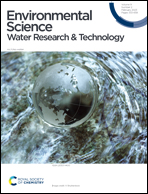Role of inner-sphere complexation in phosphate removal by metal–organic frameworks: experimental and theoretical investigation†
Abstract
In the present study, sorptive and electro-sorptive capture of phosphate using NH2-MIL-101(Al), NH2-MIL-101(Fe), and UiO-66-NH2 was investigated. Additionally, the selectivity, desorption efficiency, role of the amino linker in adsorption, and molecular-level understanding of the phosphate sorption mechanism were discerned. MOFs exhibited high adsorption capacity (NH2-MIL-101(Al): 82.58 ± 1.92 mg P g−1, NH2-MIL-101(Fe): 89.13 ± 6.14 mg P g−1, and UiO-66-NH2: 81.42 ± 2.32 mg P g−1) and fast kinetics (60–120 min). However, the poor desorption efficiency (5–20%) indicated irreversible phosphate sorption. The use of a strong base (0.01 M NaOH) for desorption compromised the stability of the MOFs. The electrosorption process aided in achieving faster kinetics (30–60 min) but failed to recover adsorbed phosphate. The amino linker allowed the removal of more than 80% of the humic acid and co-existing ions without affecting phosphate sorption. Furthermore, DFT calculations demonstrated that high adsorption energy (−265.4 to −124 kJ mol−1) and metal-phosphate interaction (inner-sphere complexation) were responsible for effective phosphate adsorption. It was established that the adsorption of a single phosphate molecule per metal-oxide core was energetically more favourable than the saturation of all-metal centres. Thus, the presence of multiple functional groups in the MOFs did not assist in the phosphate capture. Overall, NH2-MIL-101(Fe) showed the highest stability, while UiO-66 NH2 depicted the lowest phosphate adsorption energy. The selected MOFs can selectively capture phosphate present in real water samples. Nonetheless, recovering adsorbed phosphate without disrupting the MOF structure is not possible.



 Please wait while we load your content...
Please wait while we load your content...